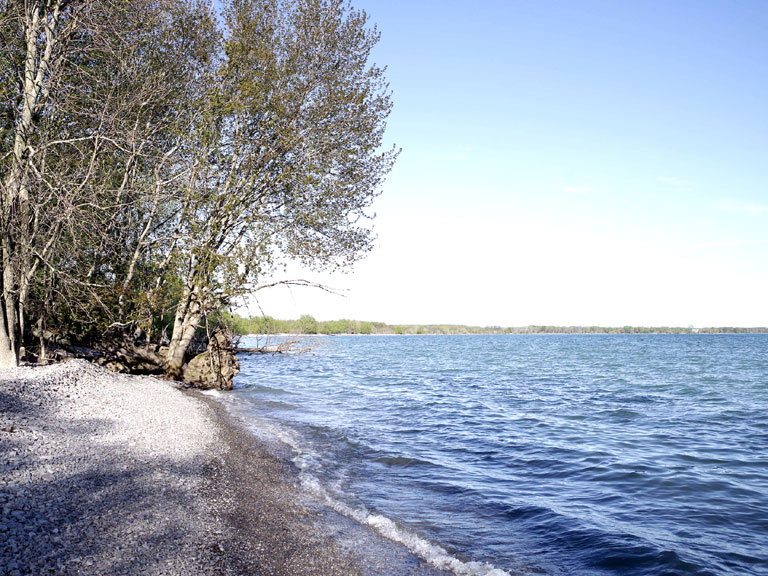County News
Mark Bass Nature Reserve

Key Prince Edward County wetland protected
Another area of land on the County’s south shore has been added to the patchwork quilt of protected places in Prince Edward County. Last Friday, which was also International Biodiversity Day, the Nature Conservancy of Canada (NCC) announced the protection of 15 hectares (38 acres) of wetland and forest along the shore of Soup Harbour. The land has been owned since 1993 by Mark Bass, who purchased it expressly for the purpose of conservation. The soon-to-retire teacher has a Master’s degree in ecological philosophy and he bought the abandoned farmland with the intention to rehabilitate it back to its natural state in an effort to promote biodiversity. Over the years he and his family, as well as students from his Grade Three classes, planted thousands of trees to create an upland forest. He also built a large pond as habitat for amphibians and reptiles. Engaging his students in the conservation effort is one of the highlights of Bass’s teaching career. “It’s been one of my greatest attempts in my classroom to promote biophilia, which is a love of the Earth,” he said. “I think we need the next generation to love the Earth with a passion, and to protect it, so I did all kinds of things to get kids out and serving nature in some way.”
The land was purchased by the NCC thanks to a generous donation from Bass’s neighbours, Nina-Marie Lister and Jeremy Guth. The couple are also very ardent about conservation and biodiversity, and they alerted the NCC that this parcel of land might be available. For Bass, this was a dream come true. “I had vowed that I would take care of this land until I died, and then the NCC phoned me and said they wanted to buy it,” said Bass. “I wouldn’t have sold it to anyone else, because now they are going to protect it and take care of it, and that’s everything I could have dreamed. For me, it is a sacred place. It is where a lot of love went into, and I know the Nature Conservancy is going to continue that vision, so I’m very pleased.”
NCC Program Director Mark Stabb said the newest addition to the growing list of protected spaces is an important one in terms of the ecology of the south shore. “We’re proud to have been welcomed in to the County to work with willing landowners to protect the land for the future. There’s a network of protected lands on the south shore that are helping to protect the natural heritage, and this is one of them. There’s a wetland that’s connected to a coastal wetland that’s important for migrating birds,” he said. “The south shore has been identified as an important biodiversity area and has drawn international recognition. This land is not public accessible at the moment, and is intended for the protection of nature. Our staff biologist is doing a biological inventory and from that we will develop a property maintenance plan. Dealing with invasive species is a top priority.”
For Guth and Lister, helping create the Mark Bass Nature Reserve is perfectly in line with their vision to preserve their own 100-acre property, which is located between two Class 1 provincially significant wetlands. “There is a major role landowners can play in the protection of their own landscapes, and in the building of a culture within the community of protecting landscapes,” said Guth. He and Lister noted that putting lands under the stewardship of the NCC was not the only way to protect it. “There are many ways landowners can collaborate with community-based conservation,” said Lister. “If you think about Prince Edward County as historically a farming community that has many different kinds of land uses, it’s like a patchwork quilt. We have wonderful places of nature— Sandbanks, Point Petre, Long Point, Little Bluff—and these are all pieces in a quilt surrounded by farmland and residential, all of which have the potential to connect, and connecting up the pieces is only possible with the participation of the landowners.” Lister and Guth see their effort with the Mark Bass Nature Reserve as part of Canada’s commitment to the Target 1 Initiative, which is a global convention on biodiversity. Canada has committed to setting aside 17 per cent of its land area for protection. Currently even though 90 per cent of Canada’s land area is Crown land, only 12 per cent of it is protected. “It feels right that by protecting even one patch of the quilt in Prince Edward County, we are helping bring Canadians closer to that target, and we are showing ways you can do it at home, in your back yard, and most importantly with our allies, the farmers, who are so integral to the County,” said Lister. “We can’t do conservation alone. If we don’t find really creative ways to protect the farms, the forests and the wetlands, we won’t make that target. We are looking for collaborative partnerships, and this is just one step.”

Comments (0)